Why dehydrate canned beans? Well, several reasons. They’re great for camping, hiking, and backpacking meals because they hydrate quickly. So you won’t need to spend a lot of time or fuel to cook meals that use them. They are also great for making homemade MREs for the same reason.
We can also use dehydrated canned beans to doctor up those store-bought freeze-dried food pouches.
Canned beans, whether they be black beans, pinto beans, kidney beans, white beans, lentils, or others, can all be dehydrated. Whereas, dehydrated home-cooked and dried beans remain hard when you rehydrate them.
Dehydrated canned beans are also shelf-stable and properly stored; they will last many months.
Beans and legumes are excellent sources of dietary fiber, protein, B vitamins, and many other important vitamins and minerals. There is evidence that suggests they can even help reduce blood sugar, boost heart health, and maintain a healthy gut microbiome.
So, let’s get started dehydrating some canned beans.
Table of Contents
- How to Dehydrate Canned Beans
- Supplies Needed for Dehydrating Beans
- Step 1. Process for Dehydrating Canned Beans
- Step 2. Preparing the Dehydrator for Dehydrating Canned Beans
- Step 3. Dehydrating Canned Beans
- Step 4. When are the Dehydrated Canned Beans Done
- Step 5. Equalizing and Conditioning the Dehydrated Beans
- Step 6. Storing the Dehydrated Beans
- Hydration
- Weights, Measures, and Serving Sizes
- Insider Tips
How to Dehydrate Canned Beans
It’s easy to dehydrate canned beans. So, pick up several cans and give it a go. You’ll be surprised how easy this is to do.
All you need to dehydrate canned beans is a good-quality food dehydrator. We use the Nesco food dehydrators. You can check out our food dehydrator guide to learn why we think Nesco offers the best bang for the buck. We believe this is the best food dehydrator for our long-term food storage needs.
Supplies Needed for Dehydrating Beans
- Food dehydrator
- Removable fruit roll sheet inserts, one for each dehydrator tray
- Standard kitchen tools, including cutting boards, chef’s knife, spatula, mixing bowls, etc
- Clear canning jars with tight-fitting lids
- Wide-mouth canning jar funnel
- Food-safe desiccant packets
- Several 15-ounce cans of your favorite canned beans
Step 1. Process for Dehydrating Canned Beans

Open your can of beans and dump the contents into a colander. We’ll need to rinse away all the thick and starchy liquid and salt from the beans so we can dehydrate them.
Step 2. Preparing the Dehydrator for Dehydrating Canned Beans
We are using removable fruit roll sheet inserts on our Nesco FD-61 food dehydrator trays for dehydrating canned beans.
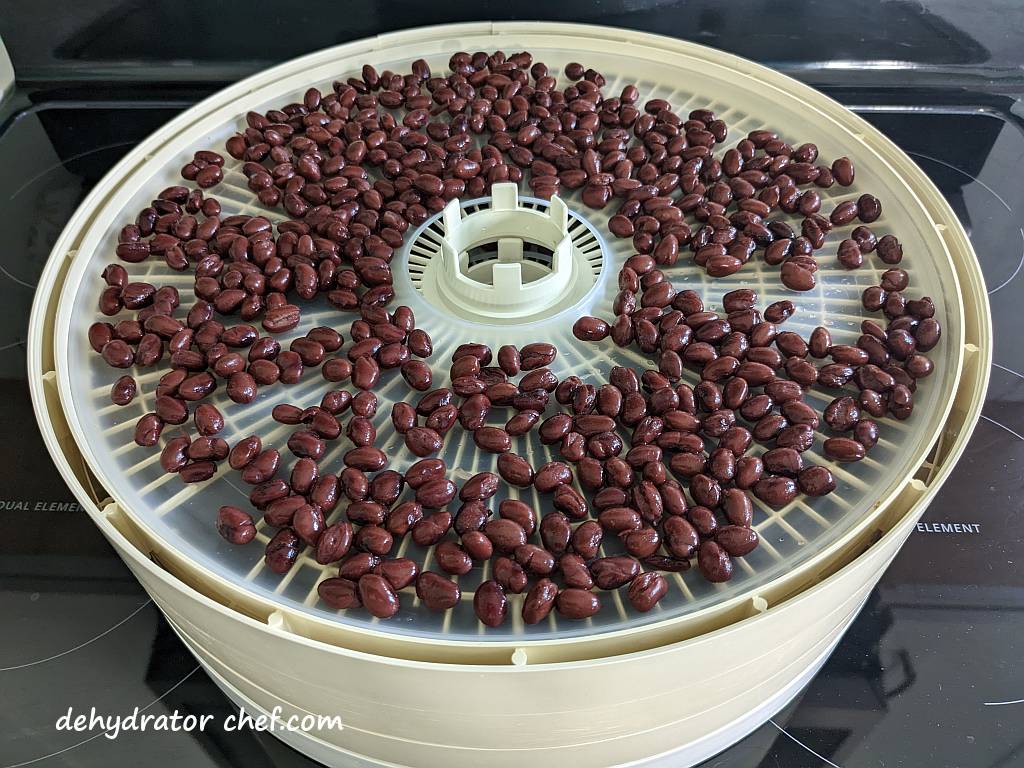
Evenly spread and layer the beans over the fruit roll sheet inserts. Spread them out for better airflow and faster dehydration. If it’s too crowded prepare another tray.
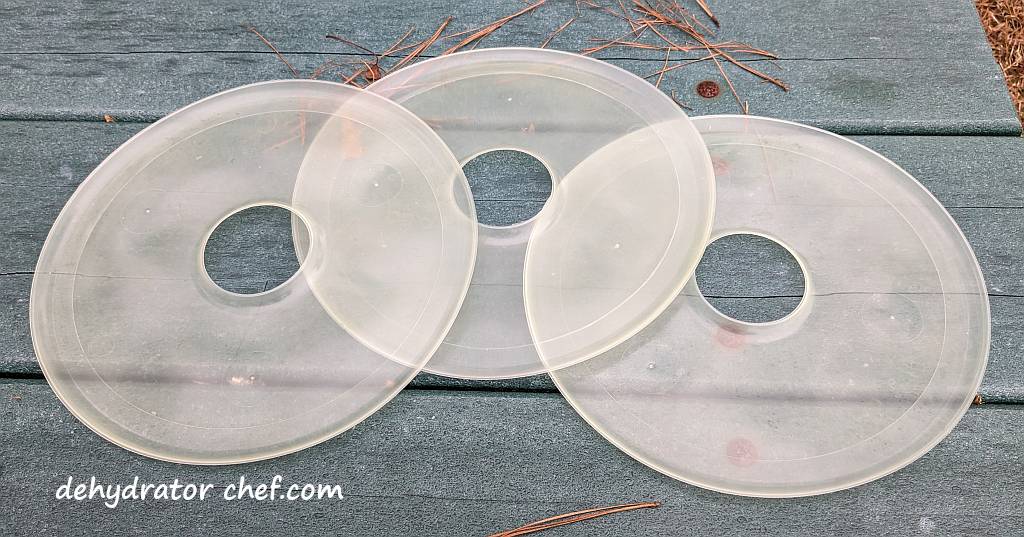
We will use these removable Nesco fruit roll sheet inserts with our Nesco FD-61 for dehydrating canned beans. They have over 3000 customer reviews with an average rating of 4.5 stars out of 5 which is evidence of a great product. Check out other Nesco food dehydrator products here.
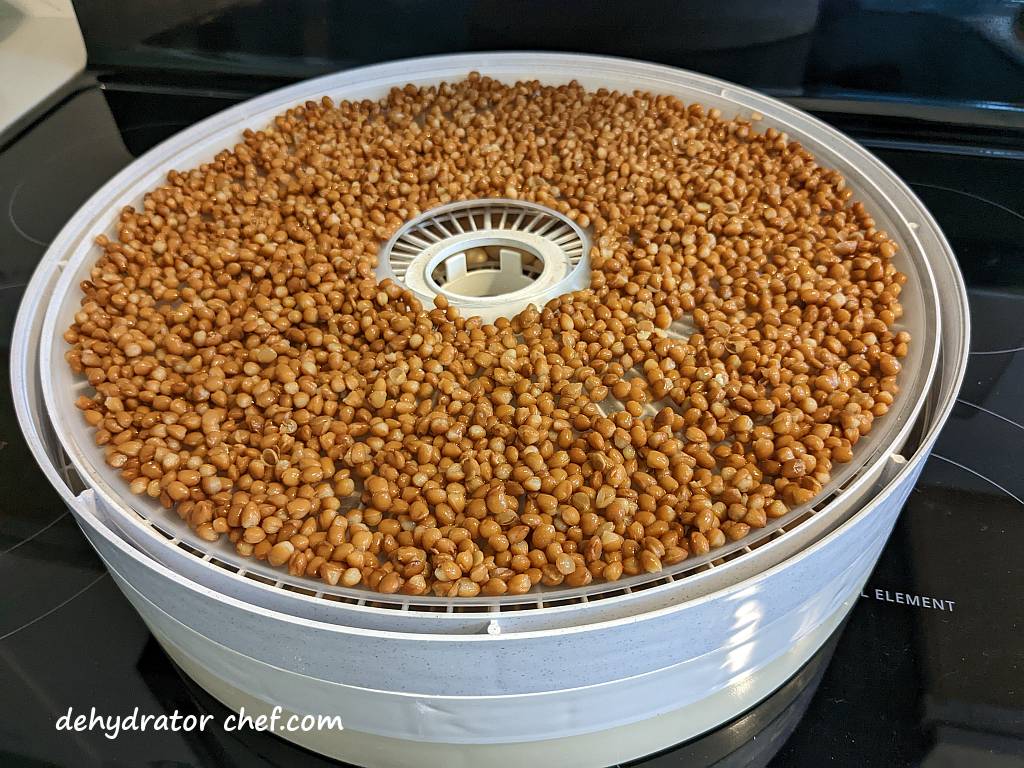
The Nesco 13.5-inch round dehydrator tray has close to 119 square inches or .8 square feet of surface area for drying.
One can of rinsed beans will easily fill one Nesco 13.5-inch round dehydrator tray with a fruit roll sheet.

Step 3. Dehydrating Canned Beans
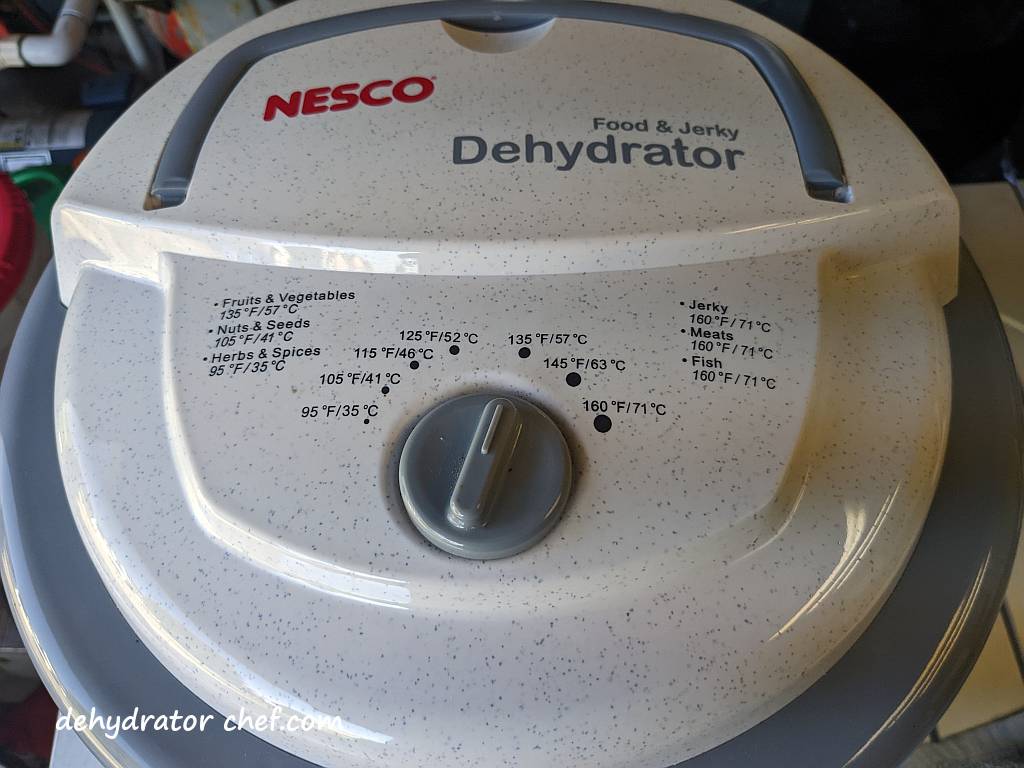
Set the drying temperature to 160 °F / 71 °C for 2 hours, then dial it back to 135 °F / 57 °C to speed up dehydration. Canned beans will dehydrate in approximately 6 to 8 hours, depending upon the ambient temperature and humidity and how crowded the trays are filled. Remember to use drying times as a guide.
Step 4. When are the Dehydrated Canned Beans Done
Start checking for doneness in 6 hours. Canned beans take 6 to 8 hours to dehydrate at 135 °F / 57 °C depending on ambient temperatures and humidity and how crowded you fill your trays.
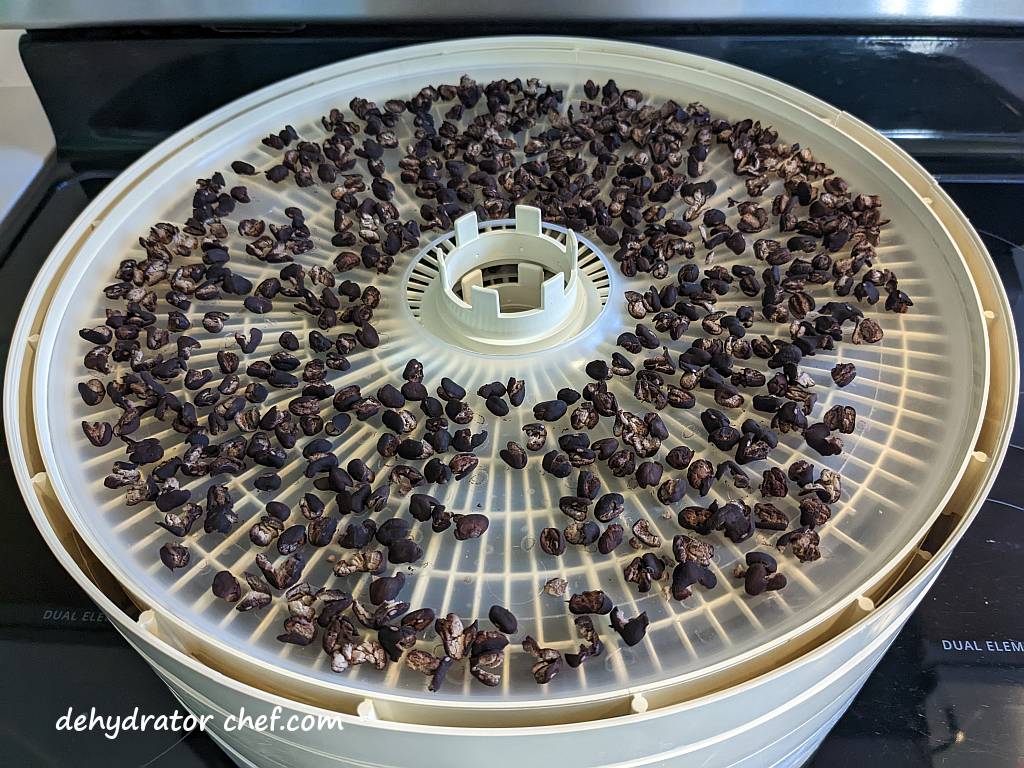
They will be crunchy if tasted and will easily break into a powder if crushed between your fingertips when finished dehydrating.
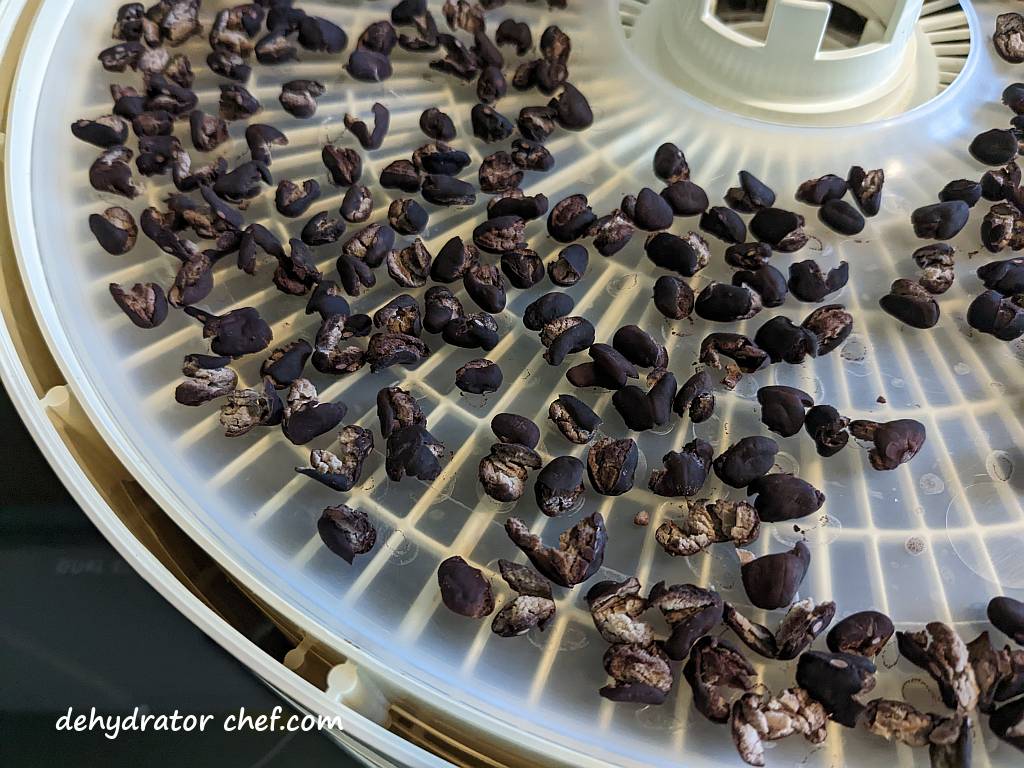
Drying times will vary depending on your dehydrator. Refer to your dehydrator owner’s manual for recommended temperatures and times for dehydrating specific foods. Remember to use drying times as a guide.
You’ll notice that the skin will break or split from the beans shrinking as they dry. This is expected.
Step 5. Equalizing and Conditioning the Dehydrated Beans
When the dehydrated beans are removed from the dehydrator, any remaining moisture in the dried beans may not be distributed equally because of their size or their location and position in the dehydrator. Equalizing and conditioning is a procedure for freshly dehydrated foods that ensures any residual moisture remaining in any piece is spread or equalized among all the other pieces in the batch. Let the dehydrated beans equalize and condition in the canning jar for 7 to 10 days.
We always recommend letting food items cool completely after they have finished dehydrating and before packing them into an airtight storage container for equalizing and conditioning. Warm food may cause sweating which could provide enough moisture for mold to grow.
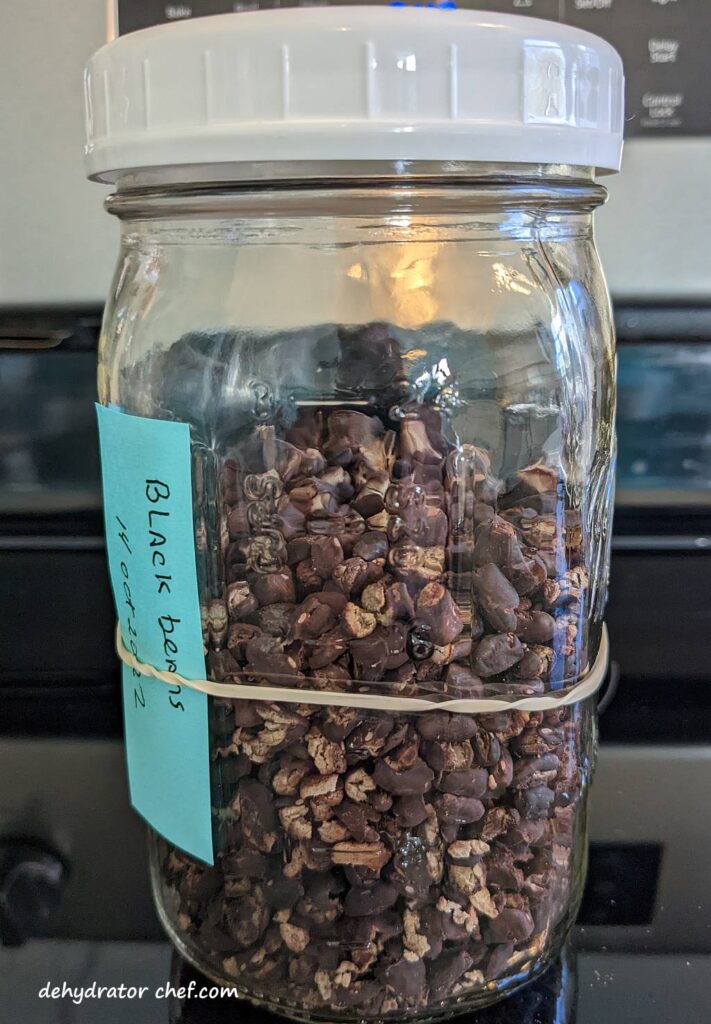
It does not take long for dehydrated food items to start hydrating from naturally occurring household humidity. Do not leave dehydrated food items exposed to the elements any longer than necessary because of the increased risk of mold growth.
After a short cooling period, pack the dehydrated beans into clean, dry, insect-proof containers with tight-fitting lids. We’ll use pint- and quart-size canning jars for this task. Fill the jars at most 2/3 to 3/4 full, leaving some headspace.
A quality stainless steel or plastic canning funnel makes the messy job of getting dehydrated foods off the dehydrator tray removable inserts and into the canning jars an easy task. Take a minute or two and check them out here on Amazon.
Every day, check the jar for moisture. Roll the jar contents around and note any clumping or sticking. If seen, put the contents back on the dehydrator for several more hours. Since canning jars are clear, it’s easy to see what’s inside.
Step 6. Storing the Dehydrated Beans
In the equalizing and conditioning phase in Step 5, we left some headspace so we could easily inspect the dehydrated beans. Now we are in the storage phase, we can now pack the dried beans into clean, dry, insect-proof containers as tightly as possible without crushing. Note, that dried beans will easily crush into bits.
We continue to use clear canning jars with tight-fitting lids as storage containers. They are transparent, making it easy to see the contents. We’re also adding moisture-absorbing desiccant packets. I don’t use a desiccant packet for moisture control during the equalizing and conditioning phase in Step 5. Doing so might mask moisture issues should the food items not be adequately dried.

We use these inexpensive food-safe desiccant packets which are available from Amazon. These 5-gram packets have over 5000 of mostly 4- and 5-star customer reviews, with an average of 4.7 stars out of 5. Our bag of 60 desiccant packets will last quite a while because they can be recharged and reused multiple times. Other food-safe sizes are available.

Do not leave your dehydrated food items exposed and unprotected any longer than necessary for the task at hand. It does not take long for dehydrated food items to naturally start hydrating from ambient household humidity. As such, this will increase the risk of mold growth.
Lastly, attach or include a short note describing the contents and the date the product was dehydrated. The note also informs us where to go in the dehydrator logbook to make another note.
Hydration
Hydrate dried beans using a 1-to-1 ratio of dehydrated beans to water.
We have used both cold water and hot water to hydrate. Plan on 15 to 20 minutes to fully hydrate.
If you’re supplementing a freeze-dried meal like we now do, just add a bit more boiling water to the pouch in the same 1-to-1 ratio.
Weights, Measures, and Serving Sizes
This information is from a recent entry from the notes we keep on most of our food dehydration projects.
One can of rinsed and drained black beans weighed in at 233 grams or 8.2 ounces. Rounding the serving sizes from “about 3.5” per can, according to the food label, to 3 would make for a serving size of 77.66 grams before any dehydration.
After dehydration, the per-serving weight was 22 grams and 1/4 cup by volume.
Insider Tips
Add these dehydrated beans to your favorite freeze-dried food pouches. Be sure to compensate by adding a bit more water as you prepare your meal.
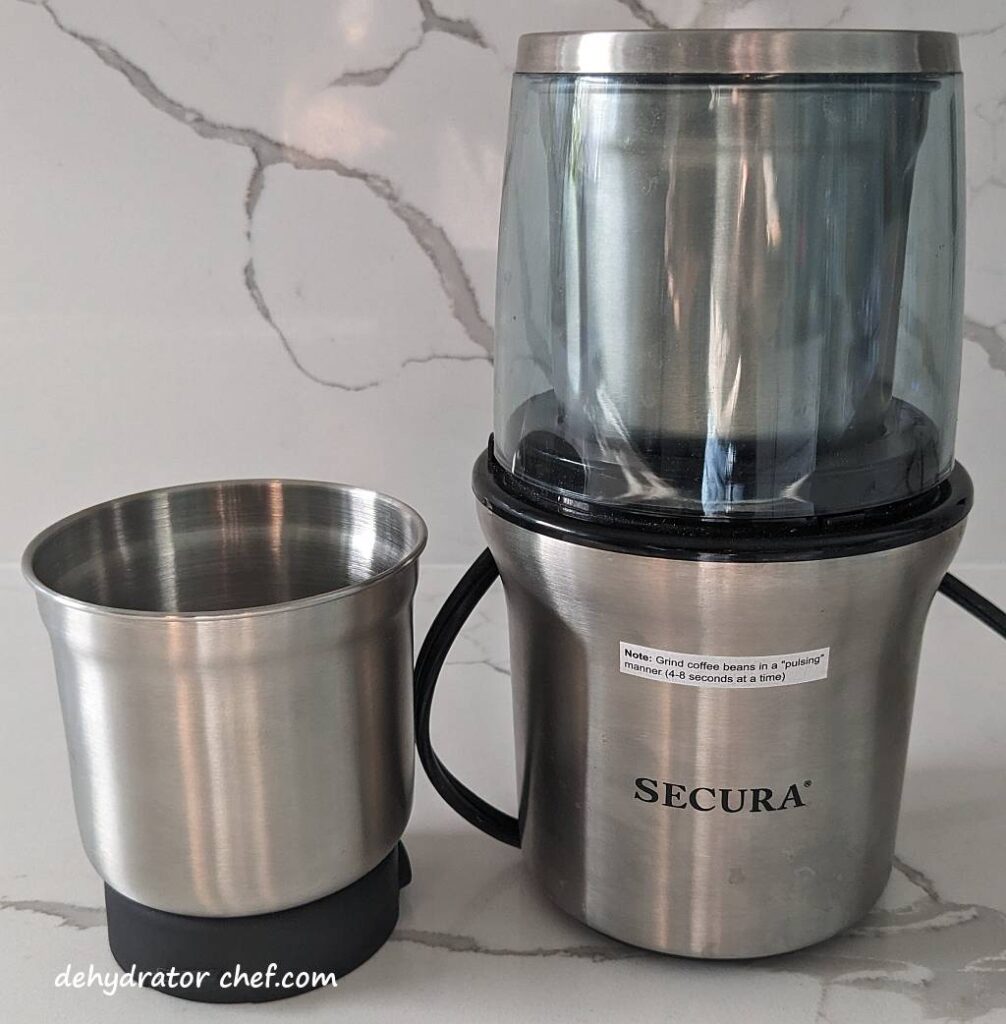
Dehydrated beans can also be powdered in a spice grinder to make thickeners or mixed with other dried ingredients to make hummus or vegetable dips. This is the spice grinder we use, it has close to 4,000 Amazon customer reviews, with an average of 4.4 stars out of 5. It comes with 2 grinding bowls, a 2-blade grinder, and a 4-blade chopper. Cleaning out the spice residue when you’re finished is also easy.
